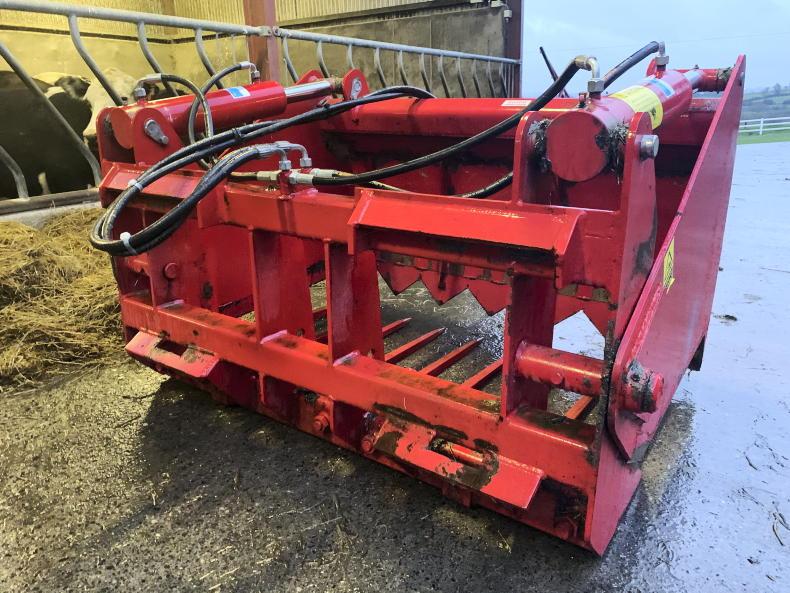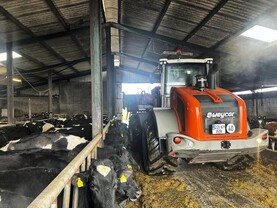For many farmers, the reality is that when spring comes around and livestock return to the fields, the shear grab is often removed from the loader and generally not looked at until housing time again.
A well-maintained sharp shear grab will leave a better pit face, require less hydraulic power and reduce feeding times. So, now is the time to carry out some routine maintenance before feeding fully commences. Alongside ensuring they are working correctly, any potential safety risks need to be rectified.
Brackets
Starting with loader brackets, it is important that they are inspected as they are the only point of contact between the loader and the shear grab.
If brackets are the bolt-on type (bolted on to the shear grab), check that buts and bolts are all present and tight. More traditional weld-on brackets should have the welds checked for cracks.
The bracket and headstock should form a snug fit once attached. Excessive movement will indicate wear. Ensure locking pins are engaging fully and freely.

Brackets regardless of type should be checked for cracks or wear.
Tines and pins
The majority of shear grabs are fitted with bolt-in tines, although some manufacturers use weld-in tines with replaceable tips. Check each tine, ensuring it is tight and not excessively worn. If loose or well worn, tighten or replace.
Missing tines will result in silage falling out on to the street, but will also increase pressure on neighbouring tines, causing them to fail also.
Standard bolt-in replacement tines will cost in the region of €40 each, but will vary depending on size.

All tines should be present and tight.

All tines should be present and tight.

All tines should be present and tight.
Pins and bushings allow the blade to pivot. If not greased regularly, these pins will wear and become loose. Worn pins will need to be replaced right away.
Blades
If a clean cut is to be achieved and maintained, then blades need to be sharpened regularly. Naturally, all blade sections should be present and in good condition. The majority of blade sections are welded on. If they are worn or broke, they need to be replaced. Individual blade sections will cost in the region of €30 each.

For top performance blades need to be sharpened regularly.
Blunt blades will not cut cleanly and take longer to do so, pulling silage to an extent, leaving a larger surface area for air to get in and spoil the exposed silage. Blunt blades also place more strain on hydraulics and on the grab’s structure, which over time may lead to cracks and/or bent pins and damaged hinge points.
Hydraulic rams and hoses
Rams and hoses should be leak-free. If oil becomes present on the ram while extended, then this generally indicates that an oil seal is damaged. If the chrome is pitted or rusted, then this can damage oil seals. Replacement ram seals start at €15, whereas new rams generally start at €250.
Check for leaking or damaged fittings. A leaking ram or fitting can eventually run the tractor or loader low on oil and lead to a costly repair if the hydraulic pump is starved of oil for a period of time. Fittings are relatively cheap, typically ranging from €20 to €40 each.
Hoses will naturally perish over time, exposing sharp strands of wire. These hoses should be replaced immediately.
Damaged hoses will eventually burst, resulting in a sudden loss of pressure and drain the loader or tractor of hydraulic oil. Hoses can range anywhere from €15 upwards, depending on length and size.

If oil is present on the piston rod, it generally indicates oil seal failure.
Lubrication and sharpening
Lubrication points should receive grease regularly. Damaged or blocked grease nipples should be replaced or unblocked.
When it comes to sharpening, proceed with caution, as a wrong move near the blade could result in nasty consequences.
It is not recommended to use an angle grinder to sharpen blades unless fitted with a buffing disc. The heat generated from a grinding disc will remove the blades’ temper, leaving them unable to maintain an edge. Instead, it is recommended that a medium grain flat file is used.
Wearing a heavy pair of gloves and eye protection, place the file at a 45° angle on the chamfered face of the blade and file it in one direction only. Working from either the top or bottom only, cover all blades evenly.
When this is done, place the file under the cutting edge again, draw the file in one direction to remove any burr that may have formed, ensuring the blade is as sharp as possible.
For many farmers, the reality is that when spring comes around and livestock return to the fields, the shear grab is often removed from the loader and generally not looked at until housing time again.
A well-maintained sharp shear grab will leave a better pit face, require less hydraulic power and reduce feeding times. So, now is the time to carry out some routine maintenance before feeding fully commences. Alongside ensuring they are working correctly, any potential safety risks need to be rectified.
Brackets
Starting with loader brackets, it is important that they are inspected as they are the only point of contact between the loader and the shear grab.
If brackets are the bolt-on type (bolted on to the shear grab), check that buts and bolts are all present and tight. More traditional weld-on brackets should have the welds checked for cracks.
The bracket and headstock should form a snug fit once attached. Excessive movement will indicate wear. Ensure locking pins are engaging fully and freely.

Brackets regardless of type should be checked for cracks or wear.
Tines and pins
The majority of shear grabs are fitted with bolt-in tines, although some manufacturers use weld-in tines with replaceable tips. Check each tine, ensuring it is tight and not excessively worn. If loose or well worn, tighten or replace.
Missing tines will result in silage falling out on to the street, but will also increase pressure on neighbouring tines, causing them to fail also.
Standard bolt-in replacement tines will cost in the region of €40 each, but will vary depending on size.

All tines should be present and tight.

All tines should be present and tight.

All tines should be present and tight.
Pins and bushings allow the blade to pivot. If not greased regularly, these pins will wear and become loose. Worn pins will need to be replaced right away.
Blades
If a clean cut is to be achieved and maintained, then blades need to be sharpened regularly. Naturally, all blade sections should be present and in good condition. The majority of blade sections are welded on. If they are worn or broke, they need to be replaced. Individual blade sections will cost in the region of €30 each.

For top performance blades need to be sharpened regularly.
Blunt blades will not cut cleanly and take longer to do so, pulling silage to an extent, leaving a larger surface area for air to get in and spoil the exposed silage. Blunt blades also place more strain on hydraulics and on the grab’s structure, which over time may lead to cracks and/or bent pins and damaged hinge points.
Hydraulic rams and hoses
Rams and hoses should be leak-free. If oil becomes present on the ram while extended, then this generally indicates that an oil seal is damaged. If the chrome is pitted or rusted, then this can damage oil seals. Replacement ram seals start at €15, whereas new rams generally start at €250.
Check for leaking or damaged fittings. A leaking ram or fitting can eventually run the tractor or loader low on oil and lead to a costly repair if the hydraulic pump is starved of oil for a period of time. Fittings are relatively cheap, typically ranging from €20 to €40 each.
Hoses will naturally perish over time, exposing sharp strands of wire. These hoses should be replaced immediately.
Damaged hoses will eventually burst, resulting in a sudden loss of pressure and drain the loader or tractor of hydraulic oil. Hoses can range anywhere from €15 upwards, depending on length and size.

If oil is present on the piston rod, it generally indicates oil seal failure.
Lubrication and sharpening
Lubrication points should receive grease regularly. Damaged or blocked grease nipples should be replaced or unblocked.
When it comes to sharpening, proceed with caution, as a wrong move near the blade could result in nasty consequences.
It is not recommended to use an angle grinder to sharpen blades unless fitted with a buffing disc. The heat generated from a grinding disc will remove the blades’ temper, leaving them unable to maintain an edge. Instead, it is recommended that a medium grain flat file is used.
Wearing a heavy pair of gloves and eye protection, place the file at a 45° angle on the chamfered face of the blade and file it in one direction only. Working from either the top or bottom only, cover all blades evenly.
When this is done, place the file under the cutting edge again, draw the file in one direction to remove any burr that may have formed, ensuring the blade is as sharp as possible.












 This is a subscriber-only article
This is a subscriber-only article










SHARING OPTIONS: